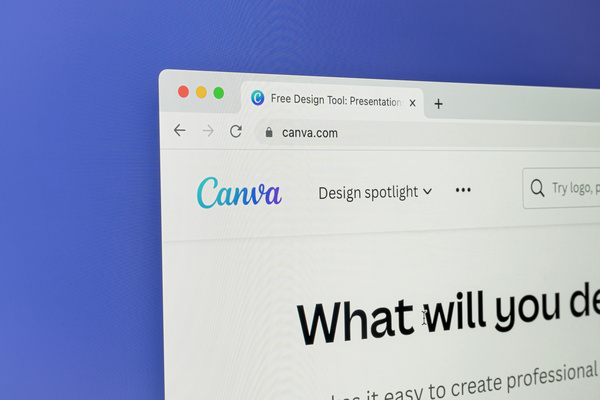Anúncios
Is your resume truly showcasing your full potential?

You might have the right talent, the ideal experience, and the perfect profile for your dream job. But if your resume doesn’t communicate that clearly, attractively, and strategically, you risk becoming just another name in the stack.
In today’s increasingly visual and competitive job market, the old black-and-white, identity-free resume model has lost its impact.
Nowadays, the ones who stand out are those who combine relevant content with flawless presentation — and that’s exactly where Canva becomes your secret weapon.
If you want to create a winning resume that grabs recruiters’ attention and translates your professional value in seconds, this guide is for you.
Resumes in 2025: do they still matter? (Spoiler: more than ever!)
It might seem like with networks like LinkedIn and automated recruiting platforms, resumes have lost their relevance. But the truth is quite the opposite: the resume is still your official introduction. It’s your sales pitch condensed into one or two pages.
The difference today is that it must go beyond simply listing information. A good resume in 2025 is strategic, visual, and tailored to its reader — whether it’s a human or screening software.
It should tell your professional story in a compelling yet concise way.
And more importantly: it needs to be memorable. The resume is your chance to be remembered even before the interview.
What makes a winning resume stand out?
A winning resume isn’t just visually appealing. It’s efficient, impactful, and straight to the point. Here are the key elements of a high-level resume:
- Clarity: the recruiter must quickly understand who you are and what you do.
- Results-focused: more than listing tasks, highlight achievements and real impact.
- Strategic design: the layout should ease reading, organize info clearly, and spotlight what matters.
- Tailored to the job: customizing your resume for each opportunity shows attention and boosts your chances.
In other words, having great content isn’t enough. You need to present it strategically — and that’s where Canva shines.
Canva: your secret weapon for creating a resume you’re proud of
Imagine being able to create a professional, polished resume without knowing a thing about design. Canva makes it possible.
It’s an online graphic design platform, intuitive and filled with ready-to-edit templates that you can personalize in just a few clicks.
You can choose a layout that fits your industry, change colors and fonts, add icons, and build something that reflects exactly who you are as a professional.
Best of all? You don’t need to install anything, and you can use it for free. For anyone who wants to make a great first impression without complications, Canva is a smart choice.
Step-by-step: from scratch to a winning resume with Canva
If you’ve never used Canva or want to learn how to build a high-impact resume there, follow these steps:
1. Create your account
Go to the Canva website and sign up quickly using your email, Google, or Facebook. In just a few seconds, you’re ready to create.
2. Search for resume templates
In the search bar, type “resume” and browse the many available templates. They range from formal and elegant to creative and modern styles.
Tip: choose a layout that matches your profession. A design role can be more bold; an admin role might need a cleaner look.
3. Replace the text with your information
Click on the text boxes and enter your real information. Start with your name, professional title, and contact details.
Then add your work experience, education, technical skills, and languages. Use bullet points to highlight achievements and measurable results.
4. Adjust the design
Want to switch to more neutral colors or something bolder? Want to change the font? Everything is clickable and editable in Canva. You can tweak the layout to your liking — just be careful not to go overboard.
Use visuals with purpose: icons to show skills, simple charts to indicate software proficiency, or lines to separate sections.
5. Review carefully
Once everything’s filled in, proofread with a critical eye. Check spelling, date consistency, spacing, and readability.
Avoid info overload or sections that don’t add value. Remember: your goal isn’t to tell everything, but to tell what really matters.
6. Save it properly
When finished, click “Share” and choose “Download as PDF.” This ensures your resume keeps its formatting and is compatible with most applicant tracking systems.
Avoid formats like .jpg or .png, which aren’t suitable for resumes.
Fatal (and common) mistakes that sabotage Canva resumes
Creating a visually appealing resume in Canva is easy — and that’s exactly why many people make mistakes that ruin the final result.
Before clicking “download,” make sure you’re not falling into any of these traps that can undo all your effort:
Overdoing the visuals
Canva is a playground for design lovers — icons, trendy fonts, vibrant colors, graphic elements… all just a click away. But be careful: a resume isn’t an art portfolio.
Too many visual elements can clutter your document, distract the recruiter, and send the wrong message — especially if the role demands professionalism.
Do use design to organize and highlight, not to dazzle.
Avoid:
- More than two main colors
- Decorative fonts that are hard to read
- Icons without a clear purpose
- Graphs that take up more space than they inform
Using generic phrases
Statements like “I’m proactive, communicative, and a team player” don’t impress anymore — they’re so overused they’ve become invisible to recruiters.
What truly makes a difference is demonstrating that with context. Use examples, highlight achievements, quantify results. A well-structured phrase with real substance is worth more than five fluffy adjectives.
Weak example:
“Responsible for customer service.”
Strong example:
“Reduced average customer support time by 30% by implementing a new service workflow.”
Disorganized layout with no visual hierarchy
Even using a template, some people make so many changes that the resume ends up cluttered and visually confusing.
Recruiters scan resumes in seconds. If they can’t quickly find your experience, education, or skills, they move on.
Use a clear structure:
- Bigger, bolded section titles
- Well-spaced content
- Consistent use of bullet points
- Subtle emphasis on key info (like job titles and dates)
Inconsistent formatting
Nothing screams unprofessional more than mismatched fonts, inconsistent date formats (“Jan/2022” in one section, “01-2022” in another), or uneven spacing.
How you visually organize your resume reflects how you organize your work. A visually consistent document shows professionalism and attention to detail.
Tip: once you’re done, do a “visual-only” review. Don’t read the content — just scan for alignment, spacing, and formatting consistency.
Conclusion: Ready to transform your career with a new resume?
Creating a high-impact resume with Canva is the first step toward landing your dream job. With a well-structured, visually compelling document aligned with your goals, your chances of standing out grow significantly — but don’t stop there.
Now that you have a winning resume in hand, it’s time to put it to work. Where and how should you share it? Which platforms truly help you find quality job opportunities?
In the next article, we’ll show you the best tools to find a job — including websites, apps, and lesser-known but powerful strategies to help you land the right interviews.
Don’t miss it: discover the essential tools to find the ideal job and make your resume work for you.
Recommended Content
